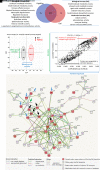Relevance of Human Aldoketoreductases and Microbial β-Glucuronidases in Testosterone Disposition
- PMID: 36623880
- PMCID: PMC10043941
- DOI: 10.1124/dmd.122.000975
Relevance of Human Aldoketoreductases and Microbial β-Glucuronidases in Testosterone Disposition
Abstract
Testosterone exhibits high variability in pharmacokinetics and glucuronidation after oral administration. Although testosterone metabolism has been studied for decades, the impact of UGT2B17 gene deletion and the role of gut bacterial β-glucuronidases on its disposition are not well characterized. We first performed an exploratory study to investigate the effect of UGT2B17 gene deletion on the global liver proteome, which revealed significant increases in proteins from multiple biological pathways. The most upregulated liver proteins were aldoketoreductases [AKR1D1, AKR1C4, AKR7A3, AKR1A1, and 7-dehydrocholesterol reductase (DHCR7)] and alcohol or aldehyde dehydrogenases (ADH6, ADH1C, ALDH1A1, ALDH9A1, and ALDH5A). In vitro assays revealed that AKR1D1 and AKR1C4 inactivate testosterone to 5β-dihydrotestosterone (5β-DHT) and 3α,5β-tetrahydrotestosterone (3α,5β-THT), respectively. These metabolites also appeared in human hepatocytes treated with testosterone and in human serum collected after oral testosterone dosing in men. Our data also suggest that 5β-DHT and 3α, 5β-THT are then eliminated through glucuronidation by UGT2B7 in UGT2B17 deletion individuals. Second, we evaluated the potential reactivation of testosterone glucuronide (TG) after its secretion into the intestinal lumen. Incubation of TG with purified gut microbial β-glucuronidase enzymes and with human fecal extracts confirmed testosterone reactivation into testosterone by gut bacterial enzymes. Both testosterone metabolic switching and variable testosterone activation by gut microbial enzymes are important mechanisms for explaining the disposition of orally administered testosterone and appear essential to unraveling the molecular mechanisms underlying UGT2B17-associated pathophysiological conditions. SIGNIFICANCE STATEMENT: This study investigated the association of UGT2B17 gene deletion and gut bacterial β-glucuronidases with testosterone disposition in vitro. The experiments revealed upregulation of AKR1D1 and AKR1C4 in UGT2B17 deletion individuals, and the role of these enzymes to inactivate testosterone to 5β-dihydrotestosterone and 3α, 5β-tetrahydrotestosterone, respectively. Key gut bacterial species responsible for testosterone glucuronide activation were identified. These data are important for explaining the disposition of exogenously administered testosterone and appear essential to unraveling the molecular mechanisms underlying UGT2B17-associated pathophysiological conditions.
Copyright © 2023 by The American Society for Pharmacology and Experimental Therapeutics.
Figures





References
-
- Amory JK, Bremner WJ (2005) Oral testosterone in oil plus dutasteride in men: a pharmacokinetic study. J Clin Endocrinol Metab 90:2610–2617. - PubMed
-
- Balhara A, Basit A, Argikar UA, Dumouchel JL, Singh S, Prasad B (2021) Comparative Proteomics Analysis of the Postmitochondrial Supernatant Fraction of Human Lens-Free Whole Eye and Liver. Drug Metab Dispos 49:592–600. - PubMed
-
- Bhasin S, Cunningham GR, Hayes FJ, Matsumoto AM, Snyder PJ, Swerdloff RS, Montori VM (2006) Testosterone therapy in adult men with androgen deficiency syndromes: an endocrine society clinical practice guideline. J Clin Endocrinol Metab 91:1995–2010. - PubMed
Publication types
MeSH terms
Substances
Grants and funding
LinkOut - more resources
Full Text Sources
Medical
Miscellaneous

